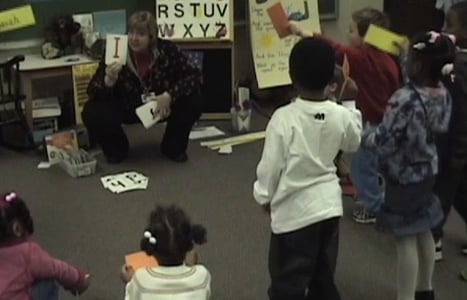
First of all, “rote” learning is not the enemy; there is a time and place for everything. It’s necessary to memorize addresses, PINs, birthdays, the speech for your award, and so much more. It’s when we stop and only use rote learning that we are doing a disservice to our children. Rote learning does not promote creative thinking, original thought, problem solving, or create new brain pathways. More importantly, if a teacher relies on a rote approach to teaching she may inadvertently turn children off to learning. Children then disengage from the activity and behavior challenges result.
What the heck IS “rote” learning anyway?
Merriam Webster: the use of memory usually with little intelligence
The Free Dictionary: A memorizing process using routine or repetition, often without full attention or comprehension: learn by rote.
In CLASS, rote learning is captured in the dimension of Concept Development with the definition, “Measures the teacher’s use of instructional discussions and activities to promote students’ higher-order thinking skills and cognition and the teacher’s focus on understanding rather than on rote instruction.” Of all the dimensions, this one has the overall lowest scores.
In a recent Pre-K Introduction to CLASS, I got out my trusty flip chart and asked the participants to define “rote learning.” I’ve learned to do this in all my trainings, as I’m finding they are not really sure. Typical responses are:
- Memorization
- Boring
- Repeat after me
- Not creative thought
I like to add that “recall” is still rote learning, even though it’s trickier. Recall simply “recalls” the facts of something they already know or have memorized rather than focusing on new or creative ideas. Let’s picture what rote looks like:
The children are sitting in a circle with the teacher holding up flash cards saying, “What letter is this?” The children visibly slump and look down at their shoes or the ceiling as the teacher goes around asking each one to identify the letter on the card (think “Letters and Book Review” video in the Pre-K Observation Training).
It’s easy for training participants to see that for children this rote learning isn’t fun, engaging, and they don’t like it! Yet, teachers do it anyway. Why?
Almost all of us have been taught with rote learning ourselves. It’s like a good old pair of shoes that fit comfortably, and we don’t have to think much about it. It’s what we choose automatically without thinking, a teaching default mode. In fact, it’s so familiar we don’t even recognize when we do it. It’s what “teaching” looks like.
We rock the foundation of teaching when we ask teachers to go beyond the familiar, the comfortable, what they have been invested in doing for years. It’s going to take time and a lot of convincing to support new ways of teaching. We have to help teachers be sensitive enough to see what happens to children when they use typical rote learning, and then what happens instead when they use more creative teaching methods.
But help is at hand. While you are facilitating your CLASS training videos, you have very good representations of rote learning and “NOT rote” learning. Here are some ideas from the Pre-K training:
In the video “Making Butterflies,” the teacher does not expand their learning or talk about butterflies in any way. It is a rote activity - coloring butterflies without any enhancement of learning. In the video “Letters and Book Review,” the teacher asks only for letter sound recognition, a recall of what she hoped they had learned before. Many of the children became disengaged because it was a rote activity, with little active engagement. By contrast, you can point out the Pre-K exemplar Instructional Learning Formats video that uses flash cards in a highly engaging way, “Using Name Cards and Letters to Engage Children in a Lesson.”
Every chance you get while you’re training in any age group, describe what rote and “NOT rote” looks like from videos. Help the participants to see that a vibrant and alive activity or discussion is engaging for the children, makes the classroom come alive, and the children, dare I say it, have FUN!
In a “NOT rote” learning activity, you can actually SEE a child thinking. The child pauses, they look at nothing for a second, and they create a new thought of their own. Take the Pre-K exemplar video in Quality of Feedback, “Encouraging a Child’s Thinking While Sorting Number Tiles.” The boy can be seen visibly thinking about how to describe the number zero.
Use the videos to show what rote learning and “NOT rote” learning looks like and how we can do better. You have the tools to be explicit, help your participants SEE it. Have fun yourself. Ask questions that promote thinking instead of memorization and recall. When you facilitate videos, make your facilitations thought provoking. Work it!

